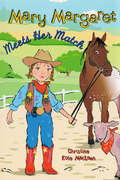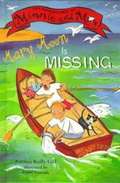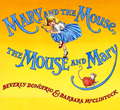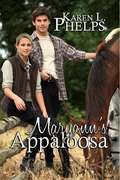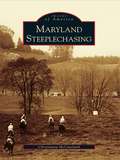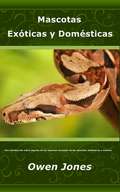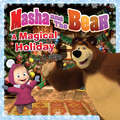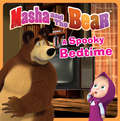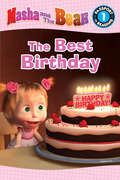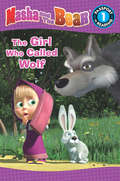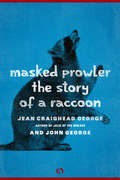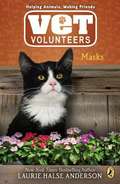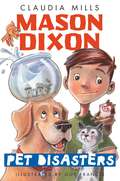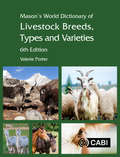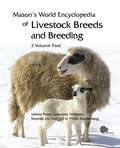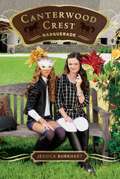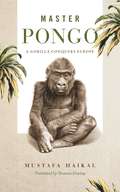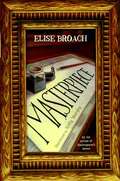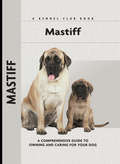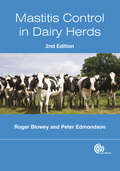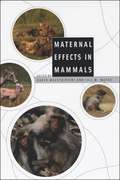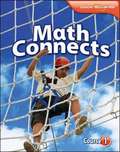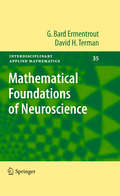- Table View
- List View
Mary Margaret Meets Her Match
by Christine MacleanFeisty middle-grader Mary Margaret rides the range in this latest adventure.Mary Margaret can't wait to go the Lazy K dude ranch. She'll finally get a pair cowboy boots, and get to ride a real horse! But things don't go exactly as planned. <P><P>She can't get her horse to cooperate, and Kansas, the riding instructor, won't let her out of the kiddie corral until she does. Kansas is one of the coolest people that Mary Margaret has ever seen, and she's determined to win her over. But when her determination goes too far, Mary Margaret has to find a way out of trouble, and back into the saddle.
Mary Moon Is Missing (Adventures of Minnie and Max #2)
by Patricia Reilly GiffMinnie's brother Orlando, owner of the Catfish Cafe, may not be sure of Minnie's detective work, but her new friend Cash and police officer Kitty the Klutz are right behind her, helping her all the way. Minnie and Cash join forces for an important case--a stolen racing pigeon, a prizewinner named Mary Moon, and the very suspicious disappearance of their friend, Bird Berry.
Mary and the Mouse, The Mouse and Mary (Mary and the Mouse)
by Beverly Donofrio Barbara McclintockMARY LIVED IN A BIG HOUSE with a very little mouse. The mouse lived in a little house inside of a very big house, with Mary. Even though Mary has been warned to stay away from mice--and Mouse has been warned to steer clear of people--the two can't help but peek at one another. Side by side, they grow up, go to college, get married, and have children of their own--Maria and MouseMouse. And then one day, Maria and MouseMouse do something surprising . . . something their parents never did. They actually come nose-to-nose and speak to one another!
Maryann's Appaloosa
by Karen L. PhelpsWhen fifteen-year-old Maryann Madigan’s parents are killed in a plane crash, she’s uprooted from a privileged Boston lifestyle to a Wyoming horse ranch. Living with an aunt she barely knows, the young woman struggles with her grief until a spirited appaloosa stallion captures her heart. There’s just one problem, she’s terrified of horses. Determined to learn how to ride, she enlists the help of Rick Ferguson, a charismatic, dark-haired cowboy who falls hard for the shy but resilient beauty. Clandestine riding lessons conquer her fear of horses and kindle their young love. When a vindictive ranch hand goes too far, Maryann must fight to save her beloved horse, her hero, and the place she now calls home.
Maryland Steeplechasing (Images of America)
by Christianna MccauslandEach spring, thousands of spectators clamber onto hillsides with picnics and binoculars to watch steeplechase racing, a fast-paced equine sport born out of the fundamentals of fox hunting. Since 1894, when the first Maryland Hunt Cup was run, the month of April has been synonymous with steeplechase racing. Starting with the Elkridge-Harford Hunt races and continuing with the National Steeplechase Association- sanctioned "Big Three" races--the My Lady's Manor, Grand National, and Maryland Hunt Cup--the countryside buzzes with horses and fans every Saturday throughout the month. Images of America: Maryland Steeplechasing traces the history of Maryland's other triple crown of racing, bringing together images of Maryland's three most-coveted races for the first time in one volume.
Mascotas exóticas y domésticas: Una introducción sobre algunos de los aspectos inusuales de las mascotas domésticas y exóticas (Como hacer... #31)
by Owen JonesHola y gracias por comprar este ebook llamado “Mascotas exóticas y domésticas”. Espero que encuentres información provechosa, útil y productiva. La información en este ebook sobre varios aspectos de las mascotas exóticas y de otros tipos se organiza en 17 capítulos de aproximadamente 500 – 600 palabras cada uno. Espero sea de interés para aquellos quienes aman a los animales. Como bonus extra, concedo el permiso para el uso del contenido en tu propio sitio web, blog o publicación Newsletter, aunque de preferencia reescríbelos primero en tus propias palabras. También puedes dividir el libro y revender los artículos. De hecho, el único derecho que no tienes es revender o donar el libro tal cual te fue entregado.
Masha and the Bear: A Magical Holiday (Masha And The Bear Ser.)
by Lauren ForteMasha & The Bear is the YouTube animated sensation that received billions of views! Join this rambunctious little girl and her best friend as they go on adventures-for the very first time, in books!Masha loves the holidays! So does the Bear, but he thinks he wants to spend it alone. When Masha finds a magic hat, she uses it to spread cheer to all of her friends. The Bear may want to be left alone, but Masha has a better idea!Comes with a pull-out poster! © 2008-2017 Animaccord LTD. All trademarks are owned by Animaccord LTD. www.mashabear.com
Masha and the Bear: A Spooky Bedtime
by Lauren ForteMasha & The Bear is the YouTube animated sensation that received billions of views! Join this rambunctious little girl and her best friend as they go on adventures-for the very first time, in books!When the Bear isn't looking, Masha watches part of a scary movie right before bed. Now she's too scared to sleep! The Bear tries to help, but he only makes things worse-now, Masha thinks there's a monster in the house! Can the Bear calm Masha down, or will they be up all night?!©2008-2017 Animaccord LTD. All trademarks are owned by Animaccord LTD. www.mashabear.com
Masha and the Bear: The Best Birthday (Passport to Reading Level 1)
by Lauren ForteMasha & The Bear is the YouTube animated sensation that received billions of views! Join this rambunctious little girl and her best friend as they go on adventures-for the very first time, in books!After the Bear's birthday, Masha gets excited about her own special day-and all of the presents she'll get. But when her birthday finally arrives, she can't find her friends. Where are they? Did they forget?!Passport to Reading Level 1© 2008-2017 Animaccord LTD. All trademarks are owned by Animaccord LTD. www.mashabear.com
Masha and the Bear: The Girl Who Called Wolf (Passport to Reading Level 1)
by Lauren ForteMasha & The Bear is the YouTube animated sensation that received billions of views! Join this rambunctious little girl and her best friend as they go on adventures-for the very first time, in books!The Bear gives his cell phone to Masha-in case she needs help. But she calls him for little things again and again! When Masha really does need help, will the Bear answer her call?Passport to Reading Level 1 ©2008-2017 Animaccord LTD. All trademarks are owned by Animaccord LTD. www.mashabear.com
Masked Prowler
by John George Jean Craighead GeorgeProcyon, a young raccoon, explores the woods, has great adventures, and learns to survive in the world around him Procyon, a raccoon born in a forest in Minnesota, lives happily with his mother, brother, and two sisters. He spends his days playing in the woods around their den, learning to find larvae and crayfish in the streambeds, and to avoid predators like Otus, the screech owl. But eventually the little raccoon must leave his family to make his own way in the world, relying on all that his mother has taught him. Suddenly, Procyon's littermates are his rivals--for food, for shelter, and for a mate. Evading humans as well as wild predators, Procyon uses his instincts and natural cunning to do what all animals must: survive and thrive. This ebook features an illustrated biography of Jean Craighead George, including rare photos from the author's personal collection.
Masks: Sunita (Vet Volunteers #11)
by Laurie Halse AndersonHalloween is coming. Sunita and her fellow Wild at Heart volunteers, Maggie, Brenna, and David are excitedly making plans for their costumes. But when Sunita's cat get's a hold of some yarn by mistake Sunita finds herself questioning just how much animal contact she should have. To take a break from the clinic, she accepts an internship at an animal research lab. Discusses many issues surrounding animal testing in a kid friendly way.
Mason Dixon: Pet Disasters (Mason Dixon #1)
by Claudia Mills Guy FrancisSoon-to-be fourth-grader Mason Dixon does not want a pet, but his parents think it will be good for him. Goldfish dies soon after his arrival (from overfeeding). Mason is relieved. Hamster escapes. Mason is relieved. Cat has to go back because best friend Brody is too allergic to ever be at their house while Cat is there. Mason is relieved. But when Dog comes, it takes a little dose of jealousy for Mason to realize he does want a pet, all of his very own. Claudia Mills introduces a new, hilarious character in Mason, and each of the three books about him will feature both boys as they cope with a new experience; pitch-perfect for 8- to 10- year-old newly independent readers, the books will maintain a consistent page count and feature black-and-while art throughout.From the Hardcover edition.
Mason's World Dictionary of Livestock Breeds, Types and Varieties
by Valerie PorterMason's World Dictionary of Livestock Breeds, Types and Varieties, now in its sixth edition, has a long history as a reliable and authoritative source of key livestock breed information. Intended as a list of livestock names and synonyms for breeds, groups, types and varieties worldwide, the dictionary aims to include all names found in the literature, 'defining' each breed or type with a brief indication of identifying characteristics, uses and source of origin. Expanded into a new edition, this established and trusted resource: Extends coverage to include yak and camelids in addition to the existing cattle, sheep, pigs, goats, horses, asses and water buffalo.Features well over 10,000 entries and cross-references on breeds, sub-breeds, types, varieties, strains and lines of species.Covers newly created and now-recognised local breeds documented over the past two decades. An important updated work, Mason's Dictionary forms a useful reference for livestock breeders and academics interested in breeds, as well as national and international organizations with interests in livestock.
Mason's World Encyclopedia of Livestock Breeds and Breeding: 2 volume pack
by Valerie Porter D. Phillip Sponenberg Stephen Hall Lawrence AldersonMason's World Encyclopedia of Livestock Breeds and Breeding describes breeds of livestock worldwide as well as a range of breed-related subjects such as husbandry, health and behaviour. This definitive and prestigious reference work presents easily accessible information on domestication (including wild ancestors and related species), genetics and breeding, livestock produce and markets, as well as breed conservation and the cultural and social aspects of livestock farming. Written by renowned livestock authorities, these volumes draw on the authors' lifelong interest and involvement in livestock breeds of the world, presenting a unique, comprehensive and fully cross-referenced guide to cattle, buffalo, horses, pigs, sheep, asses, goats, camelids, yak and other domesticants. Volume 1: contains asses, camelids, cattle, goats, horses and pigs Volume 2: contains sheep, water buffalo, yak and other livestock Coverage: Breed descriptions: including groups, types and varieties, history and links between groups, livestock products and trends for creating new breeds Wild species: ancestral and relatives, potential domesticants and hybridization Humans and breeds: spread of domestication, transhumance and pastoralism, social and cultural influences, suitability of different groups for different human purposes Genetics and Conservation: a dedicated section and glossary of terms Placing breeds in a practical agricultural context, this two volume encyclopedia will be of great value to agriculturalists, breeders, geneticists, biologists, rural historians, conservationists, ecologists, and all those who are interested in the rich diversity of livestock breeds.
Masquerade
by Jessica BurkhartCanterwood Crest Academy cordially invites you to a costume party--with a special sweetheart surprise.Canterwood is known for its fabulous parties, and Halloween is no exception. Lauren Towers is especially excited for the big day. Not only is it her favorite holiday, it's also her birthday! And this year, she and her friends will celebrate in style--by attending Canterwood's first-ever masquerade ball. What Lauren doesn't know is that there's a special someone behind a mask, just waiting to be revealed. Will this mysterious guest make this masquerade magnifique, or will her perfect birthday bash become a bummer?
Masquerade
by Jessica BurkhartCanterwood Crest Academy cordially invites you to a costume party--with a special sweetheart surprise.Canterwood is known for its fabulous parties, and Halloween is no exception. Lauren Towers is especially excited for the big day. Not only is it her favorite holiday, it's also her birthday! And this year, she and her friends will celebrate in style--by attending Canterwood's first-ever masquerade ball. What Lauren doesn't know is that there's a special someone behind a mask, just waiting to be revealed. Will this mysterious guest make this masquerade magnifique, or will her perfect birthday bash become a bummer?
Master Pongo: A Gorilla Conquers Europe (Animalibus)
by Mustafa HaikalIn the summer of 1876, Berlin anxiously awaited the arrival of what was billed as “the most gigantic ape known to zoology.” Described by European explorers only a few decades earlier, gorillas had rarely been seen outside of Africa, and emerging theories of evolution only increased the public’s desire to see this “monster with human features.” However, when he arrived, the so-called monster turned out to be a juvenile male less than thirty-two inches tall. Known as M’Pungu (Master Pongo), or simply Pongo, the gorilla was put on display in the Unter den Linden Aquarium in the center of Berlin. Expecting the horrid creature described by the news outlets of the time, the crowds who flocked to see Pongo were at first surprised and then charmed by the little ape. He quickly became one of the largest attractions in the city, and his handlers exploited him for financial gain and allowed doctors and scientists to study him closely. Throughout his time in Europe, Pongo was treated like a person in many respects. He drank beer, ate meat, slept at the home of the head of the aquarium, and “visited” London and Hamburg. But this new lifestyle and foreign environment weren’t healthy for the little gorilla. Pongo fell ill frequently and died of “consumption” in November 1877, less than a year and a half after being brought to Europe.An irresistible read, illustrated with contemporaneous drawings, this critical retelling of the expedition that brought Pongo to Berlin and of his short life in Europe sheds important light on human-animal interactions and science at a time in Western society when the theory of evolution was first gaining ground.
Master Pongo: A Gorilla Conquers Europe (Animalibus: Of Animals and Cultures #17)
by Mustafa HaikalIn the summer of 1876, Berlin anxiously awaited the arrival of what was billed as "the most gigantic ape known to zoology." Described by European explorers only a few decades earlier, gorillas had rarely been seen outside of Africa, and emerging theories of evolution only increased the public’s desire to see this "monster with human features." However, when he arrived, the so-called monster turned out to be a juvenile male less than thirty-two inches tall. Known as M’Pungu (Master Pongo), or simply Pongo, the gorilla was put on display in the Unter den Linden Aquarium in the center of Berlin. Expecting the horrid creature described by the news outlets of the time, the crowds who flocked to see Pongo were at first surprised and then charmed by the little ape. He quickly became one of the largest attractions in the city, and his handlers exploited him for financial gain and allowed doctors and scientists to study him closely. Throughout his time in Europe, Pongo was treated like a person in many respects. He drank beer, ate meat, slept at the home of the head of the aquarium, and "visited" London and Hamburg. But this new lifestyle and foreign environment weren’t healthy for the little gorilla. Pongo fell ill frequently and died of "consumption" in November 1877, less than a year and a half after being brought to Europe.An irresistible read, illustrated with contemporaneous drawings, this critical retelling of the expedition that brought Pongo to Berlin and of his short life in Europe sheds important light on human-animal interactions and science at a time in Western society when the theory of evolution was first gaining ground.
Masterpiece
by Elise BroachIn this follow-up to "Shakespeare's Secret," Broach delivers a fast-paced mystery in which a young boy and a beetle attempt to pull off a staged art heist at the Metropolitan Museum of Art.
Mastiff: A Comprehensive Guide to Owning and Caring for Your Dog
by Christina De Lima-NettoThe experts at Kennel Club Books presents the world's largest series of breed-specific canine care books. Each critically acclaimed Comprehensive Owner's Guide covers everything from breed standards to behavior, from training to health and nutrition. With nearly 200 titles in print, this series is sure to please the fancier of even the rarest breed.
Mastitis Control in Dairy Herds
by Peter Edmondson Roger BloweyMastitis in dairy herds is a worldwide problem, with significant implications for milk yields and quality, economic losses, and animal health and welfare. Effective control makes a considerable difference to the farmer and the animal, and this new edition includes updated information throughout as well as new chapters covering organic dairy herds, dry period infections, robotic milking, residue avoidance, and best practice procedures. The authors, both fellows of the Royal College of Veterinary Surgeons and recognised experts in the field, provide basic principles relevant to farmers, vets and veterinary students in a clear and practical way, covering anatomy, epidemiology, milking machines, disinfection, somatic cell counts, and diseases of the udders and teats in order to provide a thorough understanding of the causes of mastitis and measures of control and prevention. It is an indispensable resource for large animal vets, dairy industry personnel, farm managers, dairy herdsmen, and researchers and students in animal sciences and related disciplines.
Maternal Effects in Mammals
by Dario Maestripieri Jill M. MateoEvolutionary maternal effects occur whenever a mother's phenotypic traits directly affect her offspring's phenotype, independent of the offspring's genotype. Some of the phenotypic traits that result in maternal effects have a genetic basis, whereas others are environmentally determined. For example, the size of a litter produced by a mammalian mother--a trait with a strong genetic basis--can affect the growth rate of her offspring, while a mother's dominance rank--an environmentally determined trait--can affect the dominance rank of her offspring. The first volume published on the subject in more than a decade,Maternal Effects in Mammalsreflects advances in genomic, ecological, and behavioral research, as well new understandings of the evolutionary interplay between mothers and their offspring. Dario Maestripieri and Jill M. Mateo bring together a learned group of contributors to synthesize the vast literature on a range of species, highlight evolutionary processes that were previously overlooked, and propose new avenues of research. Maternal Effects in Mammalswill serve as the most comprehensive compendium on and stimulus for interdisciplinary treatments of mammalian maternal effects.
Mathematical Foundations of Neuroscience
by David H. Terman G. Bard ErmentroutThis book applies methods from nonlinear dynamics to problems in neuroscience. It uses modern mathematical approaches to understand patterns of neuronal activity seen in experiments and models of neuronal behavior. The intended audience is researchers interested in applying mathematics to important problems in neuroscience, and neuroscientists who would like to understand how to create models, as well as the mathematical and computational methods for analyzing them. The authors take a very broad approach and use many different methods to solve and understand complex models of neurons and circuits. They explain and combine numerical, analytical, dynamical systems and perturbation methods to produce a modern approach to the types of model equations that arise in neuroscience. There are extensive chapters on the role of noise, multiple time scales and spatial interactions in generating complex activity patterns found in experiments. The early chapters require little more than basic calculus and some elementary differential equations and can form the core of a computational neuroscience course. Later chapters can be used as a basis for a graduate class and as a source for current research in mathematical neuroscience. The book contains a large number of illustrations, chapter summaries and hundreds of exercises which are motivated by issues that arise in biology, and involve both computation and analysis. Bard Ermentrout is Professor of Computational Biology and Professor of Mathematics at the University of Pittsburgh. David Terman is Professor of Mathematics at the Ohio State University. "This excellent 422 page hardcover publication is an accessible and concise monograph. ... Mathematical Foundations is a timely contribution that will prove useful to mathematics graduate students and faculty interested in the application of dynamical systems theory to cellular and systems neuroscience. ... welcome addition to the pedagogical literature. ... For mathematics graduate students who are investigating the field of computational neuroscience, I would highly recommend Mathematical Foundations of Neuroscience as their first computational neuroscience text." (Gregory D. Smith, The Mathematical Association of America, December, 2010) "...it is a good substitute for a lengthy regime of abstract maths classes, but it is also well integrated into the field of neuroscience. Ermentrout and Terman's book conveys much of the advanced mathematics used in theoretical neuroscience today." (Vincent A. Billock, Nature)
